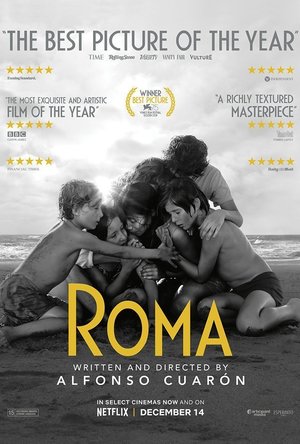Search

Workout Trainer: personal fitness coach
Health & Fitness and Lifestyle
App
Fresh, fun workouts at your fingertips! Use Workout Trainer to get in *your best shape* with...

Bobclass - Appointment scheduling, client tracking
Business and Productivity
App
Bobclass is an all-in-one productivity app for instructors, tutors, trainers, coaches and other...

Adayroi - An tâm mua sắm
Shopping and Lifestyle
App
ADAYROI.COM – Mua sắm Hàng hiệu Uy tín Online Adayroi là một trang bán hàng trực...
Justin Patchett (42 KP) rated Roma (2018) in Movies
Mar 3, 2019
Caught in a bad Roma
Contains spoilers, click to show
It’s been a long while since I watched a film deserving of a truly, harshly negative review. I have gotten so close so many times, and I’ll be damned if Netflix hadn’t gotten close to earning that with the fridge-logic that ruined Bird Box. Even Bird Box, though, feels enjoyable in retrospect compared to another Netflix exclusive: Alfonso Cuarón’s Roma.
Since I’m in a clear minority on this film, I feel obligated to preemptively address some common criticisms. If Roma had been produced in English, presented in color and with any score, it couldn’t fix the fact that I simply dislike Roma’s genre. Sure, I’ve liked slice-of-life drama films, and modern period pieces do fine by me. Pretentious Oscar-farming arthouse flicks like this, though, never win my praise.
Roma follows Cleo, a housemaid in Mexico City. Cleo has gotten pregnant and the presumed father, Fermín, leaves her to buy cigarettes before the baby’s even born. Her employer, Sofía, is dealing with a cheating spouse. What follows is two hours of both of these women marginally helping each other with their respective situations. As slice-of-life films do.
Since it's a slice-of-life film, much of the story just basically happens. You'll remember a scene here or there that happened, even if it was ultimately insignificant. In one scene for instance, Cleo goes to confront the baby daddy, who’s at a huge martial arts class. She spectates and proves to be the only one able to perform a certain yoga pose. Which is important because it helped add another few minutes to the film.
Cleo goes into labor not long after this confrontation, but her daughter ends up being stillborn. This all happens in the midst of the Corpus Christi Massacre. What the heck was the Corpus Christi Massacre, you may ask? According to this film, it was a brutal inconvenience on Cleo’s way to the hospital after her water breaks. This actual historical event simply happens and is never addressed for one second more. You know, just like in Titanic where the shipwreck just makes things inconvenient for Rose and Jack.
The last major scene in the film comes when Sofía invites Cleo to come with her family on a trip to the beach, not as staff but to help Cleo cope with the tragedy of losing her child. While they’re there, Sofía leaves the children in Cleo’s care for two freaking minutes, and two of the kids nearly drown. Cleo, though, can’t swim, and so she stands out in the water as the kids rescue each other. And that's about as close as Roma gets to a cohesive plot. Cleo only came with them to help her grieving, which meant she could be there to be powerless while her employer’s kids save each other’s lives. Bad things happen to us, the film teaches, so that good things can coincidentally happen in our proximity.
In fact, coincidence seems to be the running theme, here. Remember the Corpus Christi Massacre? No? What if I call it “the scene where Cleo goes into labor”? Maybe that helps? Fermín briefly held Cleo at gunpoint in the middle of it. Again, mere coincidence. Just like it’s a mere coincidence that she goes into labor the same day as a massacre that killed 120 people. As coincidences do.
Roma isn’t an aggressively bad film. There are a rare few moments within Roma’s 2-hour runtime where you think, “I can see that clip showing up during a Facebook video binge,” but again: These are moments more rare than our current president ordering a rare steak. That rarity has everything to do with the fact that the movie has so few moments, at all. The rest is shots that linger too long from angles that repeat themselves all too often. It’s like Cuarón asked someone, “What does a movie like Juno need to be better?” They responded, “Nothing.” So Cuarón packed Roma with nothing.
Which brings up one of my biggest criticisms of Roma: The cinematography is bland. Cuarón shot practically the entire film on one camera, set a specific distance from the subject, and kept takes running as longer than they should have, padding out a short-film’s worth of content to feature length. It’s bland cinematography that somehow earned an Oscar for Best Cinematography.
Gravity showed us what Cuarón was capable of. Beyond bringing a seemingly authentic view of space to the big screen, Gravity offered variety. Yes, the huge collision scene in Gravity takes on the feel of a one-take scene, but even then, the camera moves with the action. And if your attention moves away from the foreground the shot, you’re able to see other important things going on. With Roma, though, your foreground is your film. Period. And to be sure, you'll be kept at arm's length from that foreground at all times, both metaphorically and cinematically.
There's a number of reasons why Roma wasn't the Best Picture, this year. Gravity proved that Roma is not Cuarón’s best film. Bo Burnham–yes, that Bo Burnham–wrote and directed a better slice-of-life film with Eighth Grade. And Roma might not even be the past year’s best black-and-white film; I dare suggest that Cold War may have been better.
To give it the credit it’s due, Roma’s cast rightly earned nominations for their performances. Yalitza Aparicio and Marina de Tavira earned Best Actress nominations for their roles, and for their part, their performances were authentic as can be. It's the least the Academy could do for having them endure Cuarón's lengthy takes.
But now that I've given it credit, I demand my time back for the scene of Fermín going Star Wars Kid meets Full Monty.
Since I’m in a clear minority on this film, I feel obligated to preemptively address some common criticisms. If Roma had been produced in English, presented in color and with any score, it couldn’t fix the fact that I simply dislike Roma’s genre. Sure, I’ve liked slice-of-life drama films, and modern period pieces do fine by me. Pretentious Oscar-farming arthouse flicks like this, though, never win my praise.
Roma follows Cleo, a housemaid in Mexico City. Cleo has gotten pregnant and the presumed father, Fermín, leaves her to buy cigarettes before the baby’s even born. Her employer, Sofía, is dealing with a cheating spouse. What follows is two hours of both of these women marginally helping each other with their respective situations. As slice-of-life films do.
Since it's a slice-of-life film, much of the story just basically happens. You'll remember a scene here or there that happened, even if it was ultimately insignificant. In one scene for instance, Cleo goes to confront the baby daddy, who’s at a huge martial arts class. She spectates and proves to be the only one able to perform a certain yoga pose. Which is important because it helped add another few minutes to the film.
Cleo goes into labor not long after this confrontation, but her daughter ends up being stillborn. This all happens in the midst of the Corpus Christi Massacre. What the heck was the Corpus Christi Massacre, you may ask? According to this film, it was a brutal inconvenience on Cleo’s way to the hospital after her water breaks. This actual historical event simply happens and is never addressed for one second more. You know, just like in Titanic where the shipwreck just makes things inconvenient for Rose and Jack.
The last major scene in the film comes when Sofía invites Cleo to come with her family on a trip to the beach, not as staff but to help Cleo cope with the tragedy of losing her child. While they’re there, Sofía leaves the children in Cleo’s care for two freaking minutes, and two of the kids nearly drown. Cleo, though, can’t swim, and so she stands out in the water as the kids rescue each other. And that's about as close as Roma gets to a cohesive plot. Cleo only came with them to help her grieving, which meant she could be there to be powerless while her employer’s kids save each other’s lives. Bad things happen to us, the film teaches, so that good things can coincidentally happen in our proximity.
In fact, coincidence seems to be the running theme, here. Remember the Corpus Christi Massacre? No? What if I call it “the scene where Cleo goes into labor”? Maybe that helps? Fermín briefly held Cleo at gunpoint in the middle of it. Again, mere coincidence. Just like it’s a mere coincidence that she goes into labor the same day as a massacre that killed 120 people. As coincidences do.
Roma isn’t an aggressively bad film. There are a rare few moments within Roma’s 2-hour runtime where you think, “I can see that clip showing up during a Facebook video binge,” but again: These are moments more rare than our current president ordering a rare steak. That rarity has everything to do with the fact that the movie has so few moments, at all. The rest is shots that linger too long from angles that repeat themselves all too often. It’s like Cuarón asked someone, “What does a movie like Juno need to be better?” They responded, “Nothing.” So Cuarón packed Roma with nothing.
Which brings up one of my biggest criticisms of Roma: The cinematography is bland. Cuarón shot practically the entire film on one camera, set a specific distance from the subject, and kept takes running as longer than they should have, padding out a short-film’s worth of content to feature length. It’s bland cinematography that somehow earned an Oscar for Best Cinematography.
Gravity showed us what Cuarón was capable of. Beyond bringing a seemingly authentic view of space to the big screen, Gravity offered variety. Yes, the huge collision scene in Gravity takes on the feel of a one-take scene, but even then, the camera moves with the action. And if your attention moves away from the foreground the shot, you’re able to see other important things going on. With Roma, though, your foreground is your film. Period. And to be sure, you'll be kept at arm's length from that foreground at all times, both metaphorically and cinematically.
There's a number of reasons why Roma wasn't the Best Picture, this year. Gravity proved that Roma is not Cuarón’s best film. Bo Burnham–yes, that Bo Burnham–wrote and directed a better slice-of-life film with Eighth Grade. And Roma might not even be the past year’s best black-and-white film; I dare suggest that Cold War may have been better.
To give it the credit it’s due, Roma’s cast rightly earned nominations for their performances. Yalitza Aparicio and Marina de Tavira earned Best Actress nominations for their roles, and for their part, their performances were authentic as can be. It's the least the Academy could do for having them endure Cuarón's lengthy takes.
But now that I've given it credit, I demand my time back for the scene of Fermín going Star Wars Kid meets Full Monty.
Purple Phoenix Games (2266 KP) rated Millennial Manatees in Tabletop Games
Mar 11, 2021
I am totes Gen X. Tail end, mind you, but still not a Millennial. That said, I can still appreciate things I have missed out on due to age gaps and generational differences. I want to make so many jokes right now but I genuinely do not want to offend anyone, let alone an entire generation of people. So I won’t. Enjoy the review.
Millennial Manatees is a worker-placement(ish) card(ish) game for one to four players. In it players are assuming roles of manatees tasked with paying off their identical student loan debt: 20 coins. The first player to make wise venture investments and create the best ROI will be crowned the winner! Please keep reading. This game is not at all a powerhouse economic simulation. It’s a fun game with manatees, avocado toast, and IT COMES IN A FANNY PACK.
DISCLAIMER: We were provided a copy of this game for the purposes of this review. This is a retail copy of the game, so what you see in these photos is exactly what would be received in your box fanny pack. I do not intend to cover every single rule included in the rulebook, but will describe the overall game flow and major rule set so that our readers may get a sense of how the game plays. For more in depth rules, you may purchase a copy online directly from the publisher (or Amazon if you wish) or from your FLGS. -T
To setup carefully empty the contents of the fanny pack game box(?) and unfold the game board. Upon it will be placed separated (but shuffled) face-up decks for Basic, Salty, and Big Mood venture cards. Next to these shuffle the Volunteer cards and place the deck face-down. Shuffle the remaining Manatee cards and place somewhere around the game board. Each player chooses a color of manatee and takes all the components matching its shirt color. Unlike the photo below place all “fanatee pack” tokens with the 7 coins side face-up and each player will start the game with three coins. The players will set their debt trackers at the starting position of the debt track, and the first player receives the avocado toast token. Yes, the big one you see below.
Each round begins with the avocado toast holder and continues around the table. The first player will place their manateeple (ooh I like that one) on any card or printed space on the game board. Options include: Basic, Salty, or Big Mood venture cards, Volunteer cards, Boomer Handout board space, Take the Toast board space, and Pay Back Student Debt board space. Once the current toast holder has placed their manateeple the next player may place on any other non-occupied space or card available. Note: the Pay Back Student Debt space is always available for any number of manateeples.
For the cost in coins printed on the cards, the Basic, Salty, and Big Mood venture cards can be purchased and placed in the player’s tableau of cards. This represents the player investing in certain business ventures in the hopes of earning more coins in the long run. Once a player has a venture card in front of them the card will specify how it will be activated and the benefit therein. Many cards allow the player to collect coins, but sometimes cards allow for stealing of other players’ coins or other nefarious doings.
The volunteer cards are drawn face-down and once read by the drawing player are kept face-down in their tableau until the proper game phase activates it or the player plays it to the discard pile.
Once a player decides they want to pay down their debt they will visit the Pay Back Student Debt space on the board. When they do this they will immediately use ALL coins they have earned and apply it directly to their debt by moving their tracker down the line by the amount paid.
By placing the manateeple on the Take the Toast space, that player simply takes the toast token and becomes the first player of the next round. By placing the manateeple on the Boomer Handout space the player will gain one coin during the Manatee phase.
The Manatee phase consists of the first player flipping the top card of the Manatee deck. Most of the cards in this deck are art depictions of manatees in different attire and hairstyles. When a Manatee card is flipped during this phase, all players reference any venture cards in their tableau to see if the manatee will trigger their card. For example, a manatee may be dressed in an orange shirt, wearing sunglasses, and holding a yoga mat. For those players whose venture cards are triggered by any of these items, their cards will bestow their benefits. There are two other types of cards in this deck as well, but I will let you experience these when you play.
Turns continue in this fashion of placing manateeples in unique spaces or cards, resolving any immediate effects, playing volunteer cards, flipping and resolving Manatee cards, and paying down student debt until one player has paid off the entire sum and wins the game! Then the hardest part of the game will commence: attempting to put all the components back in the fanny pack so that they are not damaged. Good luck.
Components. This game has some pretty spectacular components coupled with some really great art. Obviously, having a game packaged in a fanny pack is just delightful, even though I typically despise non-boxed games. Secondly, all the wooden manateeples and avocado toast tokens are just amazing to behold and handle. The cards are good quality and the game features incredible art throughout. I am a big fan of this art style – it is very cartoony and very cool. This theme is just perfection and the game that lies beneath the theme is very surprising.
I say the game beneath the great art and theme is surprising because I was completely not expecting to like this one as much as I do. At its heart it is a very light worker-placement game with hints of take that and based on using currency as victory points. I like all of those mechanics quite a bit, so combining these with aforementioned art and theme works for me on another level.
I feel this game is something I can bring out with almost any crowd of adults and have a smashing great time. There are so many little jokes packed into this little game that make me giggle every time I see them. And come on, a first player token that is avocado toast? It’s too good! I love all the colors assaulting my eyes, and I love all the hate-placement that happens, and I didn’t know that I love manatees as much as I now do.
Look, I am usually pretty positive about the games I play. But I also play a lot of stinkers. This one, thankfully, delivers a super fun game experience in an hour or less, even though the theme is absolutely ridiculous. But I also find that so charming. If you are looking for that special WOW game that is relatively light but incredibly satisfying to play, I strongly recommend checking out Millennial Manatees. Purple Phoenix Games gives this one 10 / 12 soy super americanos (is that a thing?). Display the pink fanny pack with pride next to all your super-serious games and watch as your visitors flock to it and ask what it is. Then play it with them and watch them fall in love as we did. I am very happy to now have this one in my collection.
Millennial Manatees is a worker-placement(ish) card(ish) game for one to four players. In it players are assuming roles of manatees tasked with paying off their identical student loan debt: 20 coins. The first player to make wise venture investments and create the best ROI will be crowned the winner! Please keep reading. This game is not at all a powerhouse economic simulation. It’s a fun game with manatees, avocado toast, and IT COMES IN A FANNY PACK.
DISCLAIMER: We were provided a copy of this game for the purposes of this review. This is a retail copy of the game, so what you see in these photos is exactly what would be received in your box fanny pack. I do not intend to cover every single rule included in the rulebook, but will describe the overall game flow and major rule set so that our readers may get a sense of how the game plays. For more in depth rules, you may purchase a copy online directly from the publisher (or Amazon if you wish) or from your FLGS. -T
To setup carefully empty the contents of the fanny pack game box(?) and unfold the game board. Upon it will be placed separated (but shuffled) face-up decks for Basic, Salty, and Big Mood venture cards. Next to these shuffle the Volunteer cards and place the deck face-down. Shuffle the remaining Manatee cards and place somewhere around the game board. Each player chooses a color of manatee and takes all the components matching its shirt color. Unlike the photo below place all “fanatee pack” tokens with the 7 coins side face-up and each player will start the game with three coins. The players will set their debt trackers at the starting position of the debt track, and the first player receives the avocado toast token. Yes, the big one you see below.
Each round begins with the avocado toast holder and continues around the table. The first player will place their manateeple (ooh I like that one) on any card or printed space on the game board. Options include: Basic, Salty, or Big Mood venture cards, Volunteer cards, Boomer Handout board space, Take the Toast board space, and Pay Back Student Debt board space. Once the current toast holder has placed their manateeple the next player may place on any other non-occupied space or card available. Note: the Pay Back Student Debt space is always available for any number of manateeples.
For the cost in coins printed on the cards, the Basic, Salty, and Big Mood venture cards can be purchased and placed in the player’s tableau of cards. This represents the player investing in certain business ventures in the hopes of earning more coins in the long run. Once a player has a venture card in front of them the card will specify how it will be activated and the benefit therein. Many cards allow the player to collect coins, but sometimes cards allow for stealing of other players’ coins or other nefarious doings.
The volunteer cards are drawn face-down and once read by the drawing player are kept face-down in their tableau until the proper game phase activates it or the player plays it to the discard pile.
Once a player decides they want to pay down their debt they will visit the Pay Back Student Debt space on the board. When they do this they will immediately use ALL coins they have earned and apply it directly to their debt by moving their tracker down the line by the amount paid.
By placing the manateeple on the Take the Toast space, that player simply takes the toast token and becomes the first player of the next round. By placing the manateeple on the Boomer Handout space the player will gain one coin during the Manatee phase.
The Manatee phase consists of the first player flipping the top card of the Manatee deck. Most of the cards in this deck are art depictions of manatees in different attire and hairstyles. When a Manatee card is flipped during this phase, all players reference any venture cards in their tableau to see if the manatee will trigger their card. For example, a manatee may be dressed in an orange shirt, wearing sunglasses, and holding a yoga mat. For those players whose venture cards are triggered by any of these items, their cards will bestow their benefits. There are two other types of cards in this deck as well, but I will let you experience these when you play.
Turns continue in this fashion of placing manateeples in unique spaces or cards, resolving any immediate effects, playing volunteer cards, flipping and resolving Manatee cards, and paying down student debt until one player has paid off the entire sum and wins the game! Then the hardest part of the game will commence: attempting to put all the components back in the fanny pack so that they are not damaged. Good luck.
Components. This game has some pretty spectacular components coupled with some really great art. Obviously, having a game packaged in a fanny pack is just delightful, even though I typically despise non-boxed games. Secondly, all the wooden manateeples and avocado toast tokens are just amazing to behold and handle. The cards are good quality and the game features incredible art throughout. I am a big fan of this art style – it is very cartoony and very cool. This theme is just perfection and the game that lies beneath the theme is very surprising.
I say the game beneath the great art and theme is surprising because I was completely not expecting to like this one as much as I do. At its heart it is a very light worker-placement game with hints of take that and based on using currency as victory points. I like all of those mechanics quite a bit, so combining these with aforementioned art and theme works for me on another level.
I feel this game is something I can bring out with almost any crowd of adults and have a smashing great time. There are so many little jokes packed into this little game that make me giggle every time I see them. And come on, a first player token that is avocado toast? It’s too good! I love all the colors assaulting my eyes, and I love all the hate-placement that happens, and I didn’t know that I love manatees as much as I now do.
Look, I am usually pretty positive about the games I play. But I also play a lot of stinkers. This one, thankfully, delivers a super fun game experience in an hour or less, even though the theme is absolutely ridiculous. But I also find that so charming. If you are looking for that special WOW game that is relatively light but incredibly satisfying to play, I strongly recommend checking out Millennial Manatees. Purple Phoenix Games gives this one 10 / 12 soy super americanos (is that a thing?). Display the pink fanny pack with pride next to all your super-serious games and watch as your visitors flock to it and ask what it is. Then play it with them and watch them fall in love as we did. I am very happy to now have this one in my collection.

